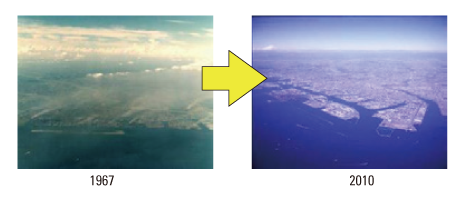INDEX
- English
- 日本語

The area covered by Kawasaki City’s Eco-town - English
- 日本語

The results of work to overcome pollution issues (photos from 1967 and 2010)
August 2020
An Eco-Town Where Resources Are Reused and Recycled

A side effect of the rapid economic growth in Japan following World War II was a worsening of pollution problems. In Kawasaki City, one of Japan’s leading industrial cities, severe pollution issues developed, including air and water pollution. However, companies, citizens and the municipality cooperated to work on overcoming the pollution. In recent years, Kawasaki’s coastal area has become a leading Japanese “eco-town,” attracting attention both inside and outside Japan.*

Kawasaki City is an industrial city in the prefecture of Kanagawa, which adjoins the Tokyo metropolitan area. It has a population of approximately 1.5 million. During Japan’s period of rapid economic growth from the 1950s to the 1970s, Kawasaki City became a core city in the Keihin Industrial Area, which is mainly focused on industries such as oil, chemicals and steel. The Keihin Industrial Area led Japan’s growth and development, but at the same time rapid industrialization brought about a severe degradation of the environment, such as air and water pollution.
To deal with these pollution issues, from the 1980s, companies, citizens and the Kawasaki City authorities have cooperated on projects to improve the environment. Companies actively invested in anti-pollution measures, developed technology to prevent pollution, and trained technicians in relevant fields. Citizens promoted environmental awareness. Meanwhile, Kawasaki City’s efforts included putting in place a relief system for victims of pollution, signing agreements with companies to prevent air pollution, and enacting pollution prevention ordinances. Thanks to these efforts, Kawasaki City was able gradually to overcome its pollution issues. As a consequence, Kawasaki steadily acquired expertise in environmental technologies, mainly in the fields of air purification and waste disposal/resource recovery. Now, the city hosts a cluster of around 400 research organizations and, alongside traditional manufacturing, areas such as medical and welfare, scientific research, and information technology are turning into significant growth industries.
Having started with pollution issues, Kawasaki City’s efforts to deal with environmental problems are still evolving and developing. Among these, the Eco-Town initiative is attracting attention domestically and abroad.
In 1997, Kawasaki City drew up a plan called the “Eco-Town Project: Environment-Conscious Town Building” that applied to 2,800 hectares of coastal land. It aimed for urban regeneration through harmony between environmental and industrial activities, and the Japanese government designated it the nation’s first Eco-Town region. From 1998, Kawasaki started full-fledged efforts to make the Eco-Town a reality.
A spokesperson for the Kawasaki International Economic Development Office describes the background to drawing up the Kawasaki Eco-Town Project.
“The change of industrial structure from heavy industry to information and service industries caused serious industrial hollowing out, and there were global environmental problems too. While facing these issues, we conceived an idea to try and minimize environmental protection costs through using the environmental technology and expertise we had accumulated, and also switch to being a world-leading industrial area.”
Kawasaki Eco-Town aims to build an economy and society based on circulating resources by taking advantage of its local characteristics and expertise in promoting environmental industries and the recycling of waste products. The Japanese government is supporting the initiative through grants to the Kawasaki Eco-Town project. Companies have moved ahead with setting up leading resource recycling facilities and research and development bases. Kawasaki City, meanwhile, is actively promoting the Kawasaki Eco-Town project within Japan and abroad.
Today, the plan has been realized and the Kawasaki coastal area has become a leading Japanese eco-town. One of its most distinctive features is the building of relationships between companies located in the area through which they make mutual use of waste products and secondary products from their business activities. This really is an ideal zero-emission structure. Notable among these is the Kawasaki Zero-Emission Industrial Complex, which is based on resource circulation and saving resources. This leading model facility for the Kawasaki Eco-Town is doing all it can to restrict waste and secondary products, while at the same time promoting reuse, resource recovery and circulatory use of energy. It attempts to minimize environmental burden; for example, by recycling types of paper such as waterproof and thermal paper that are said to be difficult to recycle, reusing water within the industrial complex, and making effective use of resources and energy.
Also, these resource recovery and circulatory reuse efforts are not limited to the Kawasaki Zero-Emission Industrial Complex but also take place in facilities throughout the Eco-Town. These work to recycle and effectively use resources through cooperation between neighboring facilities, including recycling facilities set up based on the Eco-Town plan, such as cement manufacture that uses stainless steel waste products as raw material and ammonia manufacture that employs used plastic as a raw material.
Around 1,000 observers from Japan and abroad visit the Kawasaki Eco-Town each year.
“Many of the foreign visitors come from Asia,” says the spokesperson. “Some of the observers are leaders from regional cities in South Asia. They say that when they set up industrial zones themselves, they intend to refer in particular to the Kawasaki City example. There are many similar cases among observers from other countries too. I think that the technology and expertise collected by Kawasaki City will be helpful to countries and regions that enter periods of economic growth in the future.”
Kawasaki City is speeding up its efforts as an environmentally advanced city. In February 2020, the City issued a decarbonization declaration, which aims to achieve zero carbon emissions by 2050. Moreover, it has held the Kawasaki International Eco-Tech Fair in order to spread the word of the Eco-Town’s achievements. In these ways and more, Kawasaki City continues to strive to make a global contribution.
*A town that reduces waste to zero by making use of all waste materials as raw materials in other fields

